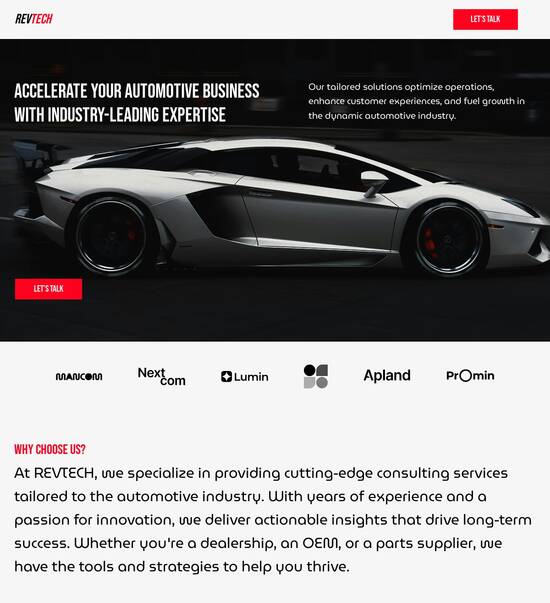
Next.js optimized registration page template
Explore Similar TemplatesAbout template
Supercharge your registration page with Next.js for outstanding performance! Learn more today.
Recommended templates

Easy to build without coding
With the intuitive drag-and-drop builder, anyone on your team can create high-converting pages without any knowledge of code or design. Make enhancements to your landing page with custom widgets using Javascript, HTML/CSS, or third-party scripts.

Multiple layouts for any industry and goal
Select from 500+ landing page layouts built to boost conversions across industry-specific scenarios. Customize them by adjusting fonts, adding images, and generating on-brand content with the AI assistant. Quickly scale with Instablocks® and Global Blocks that you can save, reuse, and update globally.

Loads fast and looks polished on any device
Every template is responsive, which means they present professionally on any device and load blazingly fast with our Thor Render Engine. You can also power them up with Google AMP technology to deliver an unparalleled mobile experience and drive higher conversions.

Robust analytics & experimentation
Get real-time updates and reporting across all your devices, showing the number of visitors, conversions, cost-per-visitor, and cost-per-lead. Launch AI-powered experiments, run A/B tests, and use heatmaps to analyze user behavior, then optimize your landing page to maximize conversions.







Easy to build without coding
With the intuitive drag-and-drop builder, anyone on your team can create high-converting pages without any knowledge of code or design. Make enhancements to your landing page with custom widgets using Javascript, HTML/CSS, or third-party scripts.
Multiple layouts for any industry and goal
Select from 500+ landing page layouts built to boost conversions across industry-specific scenarios. Customize them by adjusting fonts, adding images, and generating on-brand content with the AI assistant. Quickly scale with Instablocks® and Global Blocks that you can save, reuse, and update globally.
Loads fast and looks polished on any device
Every template is responsive, which means they present professionally on any device and load blazingly fast with our Thor Render Engine.
Robust analytics & experimentation
Get real-time updates and reporting across all your devices, showing the number of visitors, conversions, cost-per-visitor, and cost-per-lead. Launch AI-powered experiments, run A/B tests, and use heatmaps to analyze user behavior, then optimize your landing page to maximize conversions.
All the features you need to build lead-generating landing pages
Explore more featuresLearn how to build top-performing landing pages for any goal
FAQs
Leading the way in building high-performing landing pages





Creating high-converting landing pages with Instapage
A well-optimized landing page is critical for maximizing the ROI of your digital campaigns. With Instapage's robust tools and features, creating a comprehensive landing page can be done swiftly and effectively. This step-by-step guide will demonstrate how to harness these capabilities to ensure your marketing efforts drive real results.
Understanding the importance of landing pages
Landing pages serve as the primary conversion tool in your marketing funnel. They capture leads, promote products, or encourage sales. In a crowded digital space, a unique and effective landing page can significantly boost your conversion rates by offering tailored experiences that resonate with specific audiences.
- Targeted Messaging: Craft content that speaks directly to the needs and desires of your audience segments.
- Clear Call-to-Action: Use visible and compelling CTAs to guide users directly to the desired action.
- A/B Testing: Explore different versions of your page to determine what resonates most with your audience.
Step 1: Selecting the right Instapage template
Choosing the right template is crucial to the success of your landing page. Instapage offers over 100 high-converting templates that cater to various industry needs. Here’s how to select the best one for your campaign:
- Consider Your Audience: Select a template that reflects the tone and style preferred by your target demographic.
- Simplicity is Key: Don’t choose a highly complex design; a clean layout typically converts better.
- Mobile Responsiveness: Ensure the template is optimized for both desktop and mobile users to enhance accessibility.
Step 2: Customizing your landing page
Customization is a vital part of developing an impactful landing page. Use Instapage's intuitive drag-and-drop builder to modify elements per your branding guidelines and ensure they resonate with your audience.
- Dynamic Text Replacement: Use personalized elements that adapt based on the visitor's source or previous interactions.
- Brand Colors and Logos: Align the landing page’s design with your brand identity for cohesive messaging.
- Interactive Elements: Include buttons, videos, or forms that engage your users and encourage them to interact.
Step 3: Optimizing for conversions
Once your landing page is set up, optimizing for conversions is the next critical step. Instapage provides powerful optimization tools that allow you to test, analyze, and refine your landing pages effectively.
- Utilize A/B Testing: Run tests on different headlines or CTAs to see which version converts better.
- Heatmaps: Analyze user behavior on your page to identify patterns and potential improvements.
- Analyze Metrics: Make use of Instapage’s analytics dashboard to measure performance and make data-driven decisions.
In summary, building and optimizing effective landing pages with Instapage not only enhances user experience but also significantly boosts conversion rates. By following the outlined steps, marketers across various industries can create landing pages that truly perform.
Ready to amplify your digital campaigns? Start creating powerful landing pages with Instapage today. Sign up now and unleash the full potential of your marketing strategy.
Next.js optimized registration page template
Understanding the Next.js framework
Next.js is a powerful React framework designed to enhance web applications by enabling features like server-side rendering (SSR) and static site generation (SSG). With Next.js, developers can create React applications with optimized loading speeds and better performance, giving users a seamless browsing experience. This framework extends React's capabilities by providing built-in support for route management, API routes, and automatic code splitting.
The concept of server-side rendering allows pages to be generated on the server and sent to the client already populated with HTML. This leads to faster initial load times, especially crucial for applications requiring rapid interaction from users. On the other hand, static site generation pre-builds the HTML at build time, meaning users fetch a ready-made page, enhancing performance further by reducing necessary computations at request time.
Why choose Next.js for web development?
Next.js offers numerous advantages that make it a compelling choice for web development. First, it enhances performance through automatic code splitting and optimized loading. The framework ensures that users only download the essential JavaScript needed for the page they're visiting, reducing load times significantly. Additionally, SEO benefits are prominent, as search engines can easily crawl and index pages rendered on the server, improving visibility.
Performance: Fast loading times achieved through server-side rendering and static generation.
SEO advantages: Better indexing by search engines due to pre-rendered HTML.
Developer experience: Simplified routing and API handling facilitate swift development cycles.
When compared to other frameworks like traditional React or Angular, Next.js simplifies many complex tasks inherent in those environments. Developing with Next.js can significantly ramp up team productivity while simultaneously enhancing user engagement through rapid, polished interfaces.
The significance of optimized registration pages
Registration pages play a pivotal role in the user journey, particularly in user acquisition. A streamlined registration process reduces friction, encouraging potential users to convert into active members. Studies have shown that an optimized registration page can improve conversion rates by a staggering percentage, emphasizing the need for developers and marketers to focus on refining this crucial touchpoint.
Analyzing user behavior points to common frustrations on traditional registration pages. Lengthy forms, unclear prompts, and lack of feedback often lead to dropout rates that can cripple conversion efforts. Businesses that understand these pain points and actively work to address them stand a better chance of reclaiming lost users.
User experience: A smooth registration process enhances user satisfaction.
Lower dropout rates: Optimized registration pages reduce the chances of users abandoning the process.
Higher conversions: The easier the registration, the more likely users will complete it.
Next.js optimized registration page templates
An optimized registration page template incorporates various best practices and features aimed at improving user interaction. These templates provide flexibility to developers, allowing for customization based on specific application needs. Users can easily adapt these templates for different purposes, whether for e-commerce, SaaS products, or social applications.
When examining the key features of Next.js registration templates, developers can focus on essential components that contribute to an engaging UX. A sleek user interface (UI) design is paramount, ensuring that users have a pleasant experience while filling out forms. Responsive layouts are also critical, allowing users on multiple devices to navigate the registration process without issues. Furthermore, the integration of built-in validation saves time for both users and developers by providing immediate feedback on input errors.
Sleek UI design: Aesthetic and functional elements that enhance usability.
Responsive layout: Ensured compatibility across devices.
Built-in validation: Simplifies user entry through instant error checking.
Third-party integrations: Easy connection to authentication services and social logins.
Accessibility features: Ensures all users can interact with the registration page.
Using Next.js templates can lead to substantial benefits such as faster loading times due to optimizations inherent to the framework, improved SEO potential, and cost savings for developers. The combination of these advantages means that businesses can allocate resources more efficiently while also enhancing the user experience.
Development process of building a Next.js registration page
Setting up a Next.js environment is the first step in developing a registration page. To initialize a Next.js project, developers can use the command line to create a new app scaffold. Next.js provides a simple setup process, allowing developers to start focusing on writing code rather than configuring their environment. It's advisable to incorporate tools like Tailwind CSS to streamline styling, providing an efficient and maintainable design process.
Creating the registration page component requires attention to structuring logic for modularity and reusability. Developers can break down the registration form into smaller, manageable components, improving code readability and simplifying the overall design. Implementing React Hooks offers a clean solution for managing state, particularly for tracking user input in forms, which can be coupled with the handling of form submissions, whether client-side or server-side.
Initialize environment: Create a new Next.js project through command line.
Utilize Tailwind CSS: Streamline styling with utility-first CSS framework.
Develop modular components: Break down pages into reusable components for maintainability.
Implement state management: Use React Hooks for tracking user inputs.
Handle form submissions: Confirm user actions through both client-side and server-side handling.
Integrating authentication logic is another crucial aspect, whether through JSON Web Tokens (JWT) or OAuth. This ensures that user data is securely managed and safeguarded against potential threats. Following best practices in authentication helps to create a secure environment for users to register and participate in online platforms.
Customizing Next.js registration templates
Customization options for Next.js registration templates allow developers to tailor their designs to suit various applications ranging from e-commerce solutions to SaaS offerings. By adopting different layouts and unique components, developers can conduct A/B testing to understand what resonates best with their user base. This can significantly improve the overall experience for visitors and increase conversion rates.
Localization and support for right-to-left (RTL) languages are also integral to reaching a wider audience. Next.js makes it easy to create multi-language registration pages by using internationalization (i18n) support, enabling developers to serve content in a user’s preferred language. Ensuring RTL support also opens doors to various markets, enhancing inclusivity and user accessibility.
Template variations: Create tailored solutions for specific application types.
A/B testing: Explore different layouts to find the most effective design.
Localization support: Develop multi-language experiences to cater to diverse audiences.
RTL language support: Implement techniques to accommodate right-to-left languages.
Best practices for optimizing registration pages
Reducing friction in the registration process is essential for optimizing user interaction. Strategies to simplify forms, such as implementing multi-step registrations instead of lengthy single-step forms, can significantly enhance user experience. Incorporating real-time feedback through validation and error messages fosters an environment of clarity and reduces user frustration, ultimately leading to higher conversion rates.
Design principles tailored for user engagement play an essential role in encouraging users to complete registrations. Employing persuasive design elements, from visually appealing buttons to strategic color choices, aligns with brand identity and can subtly nudge users toward completing their registration. Effectively crafted clues can guide users through the process, resulting in a smoother completion and engaging experience.
Reduce form length: Consider utilizing multi-step forms to ease user efforts.
Provide feedback: Use real-time validation to guide users accurately.
Leverage persuasive design: Align buttons and colors with branding to encourage action.
Design for engagement: Create an appealing layout that encourages completion.
Advanced features and integrations
Utilizing Next.js API routes offers a convenient way to manage backend functionality, including user registration. By creating API routes, developers can handle registrations effectively and securely. This ability to connect to databases for storing user data not only enhances functionality but also centralizes user management.
Integrating analytics into the registration page aids in performance tracking and understanding user behavior. By adopting tools that monitor conversions and interactions, businesses can glean valuable insights into user patterns and areas requiring optimization. Knowing how users engage with the registration process ultimately leads to improvements and increased conversion efficiency.
Create API routes: Streamline handling of registrations through Next.js API capabilities.
Database connection: Securely store user data within a centralized database.
Integrate analytics: Track user behavior for ongoing performance enhancement.
Monitor conversions: Utilize tools to understand user drop-off points.
Challenges and solutions in developing registration pages
Potential technical challenges often arise when developing registration pages. Ensuring security when handling form data is paramount, and developers must adopt best practices to safeguard user information. Furthermore, ensuring compatibility across various browsers plays a vital role in enhancing accessibility and uptake of registration processes. Without proper testing, users may experience issues that could deter them from completing registration.
To combat these challenges, gathering user feedback should be viewed as an integral tool in refining the registration experience. Developers can iterate designs based on user testing outcomes, steadily improving the overall user journey. Including users in the testing phase can drive improvements that directly address their pain points.
Address security: Ensure form data is securely managed and encrypted.
Test compatibility: Verify that registration functions across all major browsers.
Collect user feedback: Use insights from actual users to fine-tune registration experiences.
Iterate designs: Make adjustments based on user testing data for continual improvement.
Future trends in registration page development
Emerging technologies are expected to significantly impact user registration experiences in various ways. The adoption of AI-driven personalization can lead to tailored registration experiences that react to user behavior and preferences in real-time. This directs efforts to creating an engaging and curated interface that resonates with individual users.
Developers should also prepare for anticipated shifts in user interface expectations. Innovations such as voice interfaces and biometric logins are likely to become mainstream, changing the way users interact with registration forms. Keeping abreast of these trends will be vital for effectively refining registration experiences that meet user needs.
AI-driven personalization: Enhance registration with tailored user experiences.
Voice interfaces: Adapt designs to accommodate voice-based interactions.
Biometric logins: Prepare for an increase in user demand for secure, touchless authentication.
Agile methodologies: Emphasize rapid iterations to keep pace with user expectations.
Recap of key takeaways
To summarize, Next.js optimized registration page templates offer substantial benefits in terms of performance, user experience, and scalability. By employing the outlined best practices, developers can minimize user friction while navigating the registration process, leading to higher conversion rates and improved user satisfaction.
Continuous learning and adaptation to modern web development practices are crucial for developers seeking to optimize registration experiences. Additionally, engaging with developer communities, participating in forums, and contributing to open-source projects can enhance skill sets and keep developers updated on Next.js advancements.
Efficiency: Optimized templates yield better performance.
User experience: Streamlined registration processes enhance satisfaction.
Scalability: Next.js templates cater to growing user demands easily.
Engagement: Participate in the developer community for shared learning.
Ready to skyrocket conversions?
Supercharge your ad campaigns with high-performing landing pages
Get started














